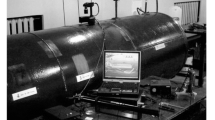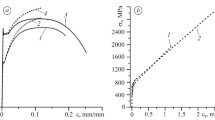Within the framework of the calculation-experimental method suggested by Pidstryhach and his followers, a athematical model for definition of residual stresses in the zone of circular welded joints of pipes with different thicknesses is developed. We constructed a functional to determine the residual thermoplastic strains on the basis of theoretical relations and experimental data obtained by a nondestructive (semidestructive) methods. Using the two-parametric criterion R6 of fracture mechanics and a failure assessment diagram constructed on its basis, the strength reserve coefficients of a welded joint of the main pipeline with different thicknesses under internal pressure and the presence of a surface crack in the thinner pipe wall are determined. The influence of residual stresses on the strength reserve coefficients is estimated.
Similar content being viewed by others
References
V. L. Berezin and A. F. Suvorov, Welding of Pipelines and Structures [in Russian], Nedra, Moscow (1983).
V. A. Vinokurov and A. G. Grogoryants, Theory of Welding Strains and Stresses [in Russian], Mashinostroenie, Moscow (1984).
V. A. Dragilev and V. A. Osadchuk, “A mathematical model for the calculation-experimental determination of residual stresses in main pipelines near assembling welds,” Rozv. Rozr. Naft. Gaz. Rod., No. 1(14), 24–29 (2005).
O. O. Ivanchuk and V. A. Osadchuk, “A mathematical model for the calculation-experimental diagnostics of a stress state of circular welded joints of pipes with different thicknesses in main pipelines,” Metod. Pryl. Kont. Yak., No. 5, 97–100 (2005).
V. I. Kyr’yan, V. A. Osadchuk, and M. M. Nykolyshyn, Fracture Mechanics of Welded Joints of Metallic Structures [in Ukrainian], SPOLOM, Lviv (2007).
A. A. Dubov, E. A. Demin, A. I. Minaev, and O. I. Steklov, “Control over a stress-strain state of gas pipelines,” Gaz. Prom., No. 2, 58–61 (2002).
V. I. Makhnenko, Numerical Methods of Studying the Kinetics of Welding Stresses and Strains [in Russian], Naukova Dumka, Kiev (1976).
V. I. Makhnenko, “Improvement of the methods of estimation of the residual service life of welded joints of structures under longterm operation,” in: Collection of Main Publications of Employees of the Department of Mathematical Methods of Study of Physical-Chemical Processes in Welding and Special Electrometallurgy of E. O. Paton Institute of Electric Welding of the Ukrainian Academy of Sciences [in Russian], E. O. Paton Institute of Electric Welding, Kiev (2004), pp. 3–12.
V. I. Makhnenko, Service Life of the Safety Operation of Welded Joints and Units of Modern Structures [in Russian], Naukova Dumka, Kiev (2006).
L. M. Lobanov, V. A. Pivtorak, V. V. Savitskii, and G. I. Tkachuk, “A method of determination of residual stresses in welded joints and elements of structures with the use of speckle-interferometry,” Avtom. Svar., No. 1, 25–30 (2006).
A. Ya. Nedoseka, Foundations of Calculations and Diagnostics of Welded Joints [in Russian], IND PROM, Kiev (1998).
V. A. Osadchuk, “The diagnostics of residual technological stresses in elements of structures by the numerical-experimental method,” Mat. Met. Fiz.-Mekh. Polya, 46, No. 1, 88–104 (2003).
V. A. Osadchuk, Yu. V. Banakhevich, and O. O. Ivanchuk, “Determination of the stress state of main pipelines in the zone of circular welds, Fiz.-Khim. Mekh. Mat., 42, No. 2, 99–104 (2006).
Ya. S. Pidstryhach and S. Ya. Yarema, Thermal Stresses in Shells [in Russian], AN Ukr. SSR, Kiev (1961).
Ya. S. Pidstryhach and V. A. Osadchuk, “Study of the stress state of cylindrical shells caused by a given tensor of inconsistent strains and its application to the determination of welding stresses,” Fiz.-Khim. Mekh. Mat., 4, No. 2, 218–224 (1968).
Calculations of the Strength of Operating Main Pipelines with defects. VBN V.2.3–00018201.04–2000 [in Russian], Gosneftegazprom, Kiev (2000).
V. N. Shimanovskii, E. F. Garf, V. A. Permyakov, et al., Types of Structures [in Russian], Naukova Dumka, Kiev (1997), Vol. 2; L. M. Lobanov (Ed.), Welded Building Structures, Vols. 1–3.
B. S. Kasatkin, A. B. Kudrin, L. M. Lobanov, et al., Experimental Methods of Study of Strains and Stresses: Reference Book [in Russian], Naukova Dumka, Kiev (1981).
Fitness-for-Service. American Petroleum Institute. Recommended Practice 579 (2000).
R. P. Harrison, K. Loosemore, J. Milne, and A. R. Dowling, Assessment of the Integrity of Structures Containing Defects, CEGB R6 (1980).
J. Milne, “Failure assessment diagrams and estimates: A comparison for ferritic and austenitic steels,” Int. J. Press. Vess. Piping, 13, 107–125 (1983).
Author information
Authors and Affiliations
Additional information
Translated from Matematychni Metody ta Fizyko-Mekhanichni Polya, Vol. 51, No. 2, pp. 133–146, April–June, 2008.
Rights and permissions
About this article
Cite this article
Osadchuk, V.A., Porokhovs’kyi, Y.V. & Ivanchuk, O.O. Diagnostics of residual stresses and estimation of their influence on the static strength of welded joints of pipes with different thicknesses with crack-type defects. J Math Sci 162, 161–179 (2009). https://doi.org/10.1007/s10958-009-9628-3
Received:
Published:
Issue Date:
DOI: https://doi.org/10.1007/s10958-009-9628-3




